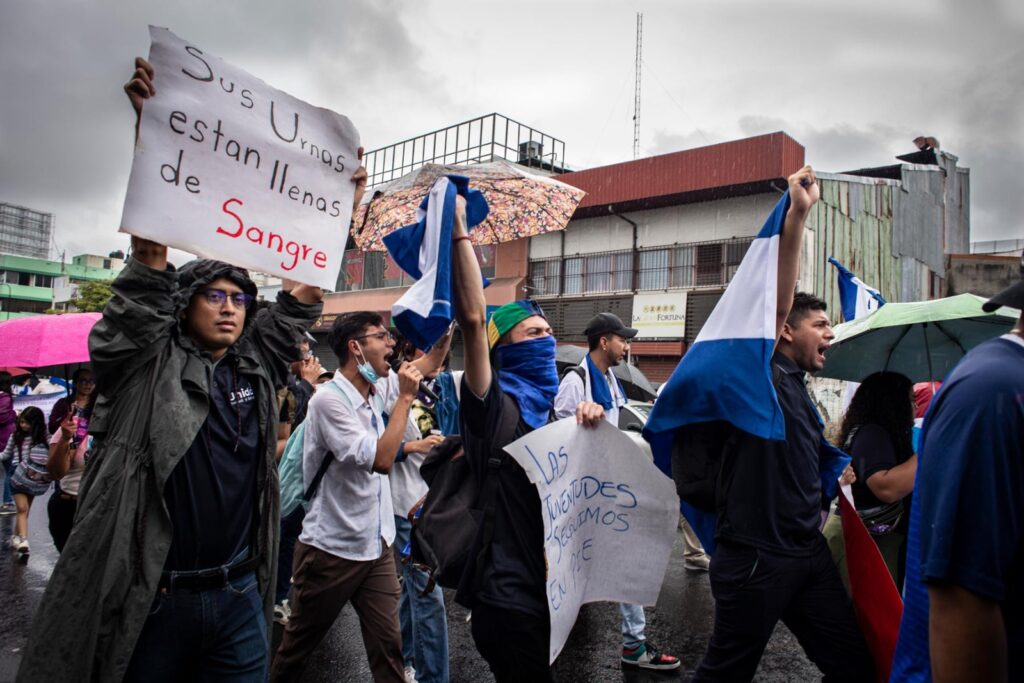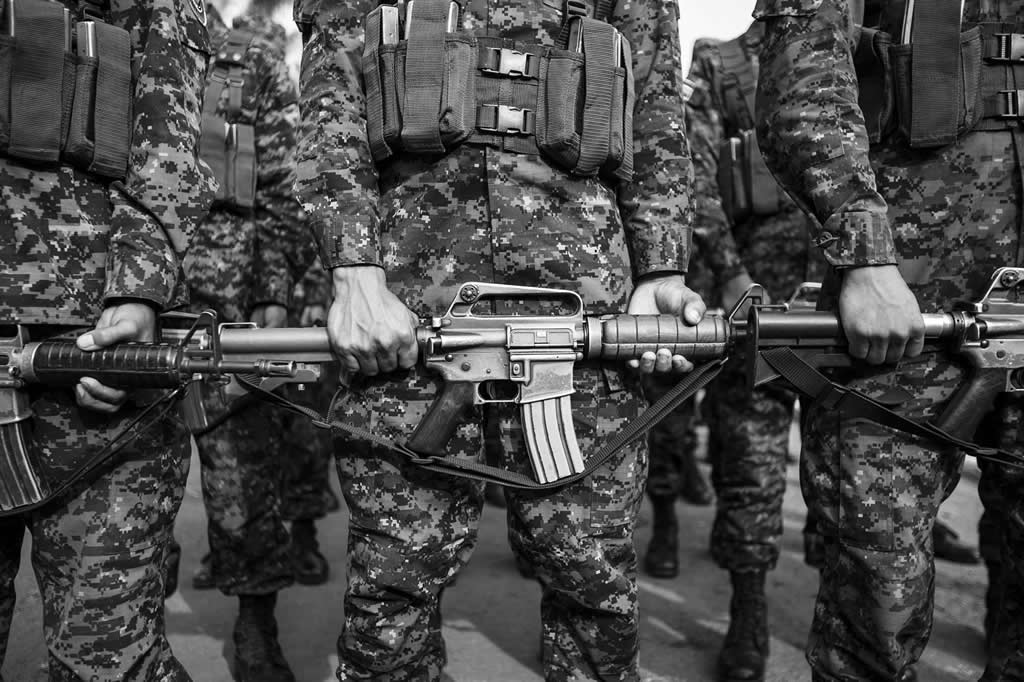Extrajudicial executions
Faced with the outbreak of mass peaceful demonstrations in April 2018, the National Police and pro-government armed groups responded with violence to suppress them. Police officers and members of pro-government armed groups, acting jointly and in a coordinated manner, committed extrajudicial executions during the crackdown on the protests that took place between 18 April and 23 September 2018.

The GHREN investigated 40 deaths in the context of protests and concluded that extrajudicial executions had been committed in each of these cases. To corroborate the patterns identified in the cases investigated, it examined a further 75 deaths in the context of the 2018 protests. The GHREN has reasonable grounds to believe that the cases investigated are representative of broader patterns of conduct, which were replicated in a systematic and widespread manner over several months, and virtually throughout the entire national territory.
The Government of Nicaragua officially recognizes 198 deaths in the context of the protests. However, it attributes responsibility to the people who participated in the protests, which it characterizes as a «attempted coup». In the absence of reliable official data, human rights bodies and civil society organizations developed their own records of deaths and injuries:
| Source | Period | Fatalities | Deceased civilians | Deceased police officers |
|---|---|---|---|---|
| Government of Nicaragua1 | 19/4 – 13/9, 2018 | 198 | 176 | 22 |
| GIEI Nicaragua2 | 18/4 – 30/5, 2018 | 109 | 106 | 3 |
| IACHR3 | 18/4 – 1/10, 2018 | 350 | 332 | 23 |
| Truth, Justice, and Peace Commission (CVJP)4 | 18/4, 2018 – 15/7, 2019 | 251 | 229 | 22 |
| CEJIL5 | 18/4 – 1/10, 2018 | 342 | 319 | 23 |
1 Report of the State of Nicaragua Regarding the Joint Communication of the Special Procedures of the United Nations Human Rights Council (26 November 2018).
2 GIEI Nicaragua, Report on the violent events that took place between April 18th and May 30th, 2018, p. 178.
3 MESENI database shared by the IACHR with the GHREN.
4 CVJP, Fourth Preliminary Report, Annex II.
5 Record provided by CEJIL to the GHREN.
1 – Perfiles de las víctimas
The majority of the people killed in the context of the 2018 protests, including in marches and demonstrations, occupations of public spaces such as university facilities, and «tranques» 6 and barricades, were protesters. People who were in the vicinity of the protests, sympathizers of the Sandinista National Liberation Front (FSLN) and/or members of pro-government armed groups, and 22 National Police officers were also deceased.7 Young men accounted for the highest percentage of deaths and serious injuries. Fifteen or 16 deaths of women were reported (depending on the source); however, there is little information regarding the circumstances of these deaths.
Out of the 115 deaths analyzed, the GHREN was able to establish that 77 correspond to demonstrators, 24 to people who were in the vicinity of protest sites, four were police officers, two were people providing humanitarian support to demonstrators, and one was a journalist; in six cases the profile of the victim could not be established.
6 In Nicaragua «tranque» refers to a common form of protest which consists in holding road and street blockades.
7 The GHREN requested information from the Government on the deaths of people with these last three profiles but did not receive a response.
2 – Patterns of violations
a) Use of lethal weapons
The Group noted the consistent use of firearms by Police and pro-government armed groups to repress protests since 19 April 2018, including handguns, shotguns, assault rifles, sniper rifles, and machine guns. Multiple credible sources referred to the presence of armed individuals on rooftops of houses and buildings, which they identified as «snipers». This positioning denotes the intention to employ combat tactics and produce the death of demonstrators, instead of using crowd control techniques or other appropriate tactics to de-escalate situations.
Records compiled by various sources show a high number of deaths by firearms. It is estimated that between 70 and 80 percent of the deaths were caused by gunshot wounds, and most of them by bullet wounds in vital areas. The cases investigated by the GHREN confirm these patterns: of 40 cases investigated in-depth, 39 victims died due to gunshot wounds, all of them presenting impacts in vital areas.

b) Coordination between the National Police and pro-government armed groups
The GHREN’s analysis of 40 extrajudicial executions identified that in most cases, police agents and members of pro-government groups acted jointly and in a coordinated manner. In four cases there are no elements that point to the direct participation of police agent; however, the pro-government armed groups acted with total impunity.
The Government has denied the arbitrary use of force by the Police and the existence of pro-government armed groups. High-ranking Government officials justified the actions of non-uniformed armed persons, identifying them as «volunteer police officers».8 However, according to the Organic Law of the Police, volunteer police officers can only assist the police in prevention tasks, must be duly uniformed, and are not authorized to use firearms.9
Numerous sources, including testimonies of former members of pro-government armed groups, indicated that these groups were integrated by FSLN sympathizers, including Sandinista Youth, employees of public institutions, ex-military, and gang members, and that they were recruited and coordinated by persons trusted by high-level government officials.
Most of the people who participated in the demonstrations did so peacefully. However, repression by police and pro-government armed groups caused clashes with protesters. While the protest movement remained predominantly peaceful, some protesters committed acts of violence such as stone-throwing, and the use of homemade mortar devices and, in some cases, firearms, to repel attacks by police and pro-government armed groups. In some cases, criminal practices took place in the context of the roadblocks, such as unlawful toll collection, robbery, and even kidnapping.
Such acts do not justify the actions of the police who fired on demonstrators in a systematic manner and jointly with armed groups that are not authorized to use force. The GHREN concluded that in all cases investigated, extrajudicial executions were committed by the police and/or pro-government armed groups. The Group did not receive information regarding any incidents in which it may be possible to assert that the death was the result of the proportional or lawful use of force by the police.
High levels of organization, coordination, and repressive capacity were observed from mid-June onwards in the actions of the Police and pro-government groups, which materialised in a series of joint operations popularly known as the «Clean-Up Operation». These were carried out in different departments of the country with the goal of dismantling the roadblocks and barricades and were characterized by the use of substantial material and logistical resources and weapons, and of highly specialized and predominantly violent tactics.
Most of the attacks against roadblocks and barricades took place in the early hours of the morning or during the night, and in some cases were preceded by power and telephone outages. This hindered the protesters’ ability to react and communicate, and to record photographic and video evidence. The operations carried out in Carazo on 8 July; at the National Autonomous University of Nicaragua and the adjacent Church of the Divina Misericordia in Managua on 13 July; in Masaya on 17 July; and in Jinotega on 23 July, were particularly violent.
After these violent operations, which were accompanied by mass arrests, acts of social protest decreased considerably. The last large-scale march took place on 23 September; on 28 September the Police declared public demonstrations illegal.
8 Interview with Daniel Ortega in Euronews, July 30, 18, available at: https://www.youtube.com/watch?v=NiR0R4hYCuA; interview with Francisco Diaz, Chief of the National Police, 11/30/2018, available at: https://youtu.be/zB_VD2JuGG0.)
9 Law No. 872, arts. 23-26.
c) Denial of medical care
The GHREN has reasonable grounds to believe that following orders from the Minister of Health, the directors of health centers and hospitals throughout the country were instructed to deny entry and medical attention to protesters and to report persons arriving at health centers to the police.
Injured persons and their families suffered discrimination at medical facilities, and some of them were subjected to intentional medical malpractice, including denial of care and lack of specialized care and treatment commensurate with the severity of their injuries. Health professionals who challenged the instruction suffered reprisals, including detentions, threats, harassment, and dismissal.
d) Impunity and obstruction of access to justice
The GHREN requested information from the Government on the progress of investigations into killings committed by police and members of pro-Government armed groups, but at the time of writing, it had not received a response. The Group is not aware of any convictions of police agents or members of pro-Government groups for the violations and abuses committed. On the contrary, several high-ranking officials allegedly involved in the repression were promoted.
The authorities obstructed efforts to ascertain the circumstances of the deaths in cases of extrajudicial executions. Medical and police personnel demanded that victims’ relatives sign declarations waiving their rights to denounce the events and to request an autopsy in order to be able to retrieve the body of their relative or to obtain a death certificate. The authorities also attempted to manipulate death certificates to hide the fact that the cause of death was due to gunshot wounds.
Furthermore, in several documented cases, the Public Prosecutor’s Office refused to receive complaints regarding the deaths of demonstrators. In the cases in which it did register the complaint, the Prosecutor’s Office did not take the necessary steps to further the investigation. In several cases, civilians proceeded to clean the streets of bullet casings, blood, and other evidence hours after the armed attacks.
Finally, the adoption of the Amnesty Law on 8 June 2019 entailed the closure of all investigations into deaths during the protests, guaranteeing impunity for police and members of pro-government groups allegedly involved in the killings, unlawful arrests and detention, and torture.